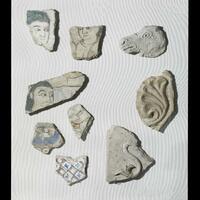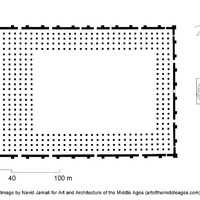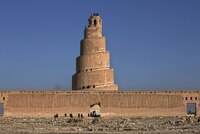Remains of Samarra
Type:
Cities,
Mosques,
Mihrabs,
Palace complexes,
Doors
Date:
836–92
Location or Findspot (Modern-Day Country):
Iraq
Description:
In 836, the caliph Harun al-Rashid (also known as al-Mu'tasim, r. 833–42) moved the Abbasid capital from Baghdad to Samarra, where he and his successors built extensive palace complexes. The capital was moved back to Baghdad in 892, after which point the population gradually declined. For this reason, the site retains much of its ninth-century architecture, although largely deteriorated because of the fragility of mud brick.
Notable remains include the spiral minaret of a mosque associated with caliph al-Mutawakkil (r. 847–61), carved or molded stucco decoration from various types of buildings, and painted figures of women. One of the stucco carving styles from Samarra, the so-called Beveled Style, is also preserved in luxury export goods, for instance a pair of carved teak doors that were probably produced by artisans in Samarra but ended up in Takrit (Iraq).
Notable remains include the spiral minaret of a mosque associated with caliph al-Mutawakkil (r. 847–61), carved or molded stucco decoration from various types of buildings, and painted figures of women. One of the stucco carving styles from Samarra, the so-called Beveled Style, is also preserved in luxury export goods, for instance a pair of carved teak doors that were probably produced by artisans in Samarra but ended up in Takrit (Iraq).
Relevant Textbook Chapter(s):
5
Repository and Online Resources:
• Read more about Samarra on the website of UNESCO's World Heritage List.
• Listen to a podcast on the wall-paintings fragments in the BBC series "A History of the World in 100 Objects."
• Read more about the wall-paintings fragments on the website of the British Museum.
• Read more about the wood doors on the website of the Metropolitan Museum.
Image Credits:
Wikimedia Commons, Metropolitan Museum, © Trustees of the British Museum, Navid Jamali








